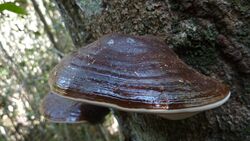Biology:Ganoderma tornatum
| Ganoderma tornatum | |
|---|---|

| |
| Scientific classification | |
| Domain: | Eukaryota |
| Kingdom: | Fungi |
| Division: | Basidiomycota |
| Class: | Agaricomycetes |
| Order: | Polyporales |
| Family: | Ganodermataceae |
| Genus: | Ganoderma |
| Species: | G. tornatum
|
| Binomial name | |
| Ganoderma tornatum (Pers.) Bres., (1912)
| |
| Synonyms | |
|
Elfvingia australis (Fr.) G. Cunn., (1965) | |
Ganoderma tornatum is a fungal plant pathogen in the genus Ganoderma. It is a species of basidiomycete fungi in the family Polyporaceae. Members are also known as bracket fungi, or polypores.[1]
Description
Like other polypores, its physical characteristics include a rigid and tough texture and a shelf-like appearance.[2] Most specimens of G. tornatum have a dark brown upper surface, though the ones found in the northwest of India and Pakistan have a lighter appearance. G. tornatum also have thin, shiny horn-like layers, distinguishing them from G. applanatum. It does not have a long and thin stipe like G. cochlear.[3]
Physiologically, their mode of transmission is likely primarily through air-borne spores, as no rhizomorphs have been found. [4] While temperature increases decrease their spore size [5] its spore size was found to be 7.5–9.5 x 5–7 micrometers in one sample. In addition to parasitizing oil palms, G. tornatum has a variety of hosts, in comparison to other Ganoderma species.[6]
Distribution and habitat
It is distributed widely throughout the tropics, appearing to be one of the most common species of Ganoderma there. Some places it occurs is south of the Sahara desert, the shores of the Pacific Ocean in Canada, and the north west of India and Pakistan, and from the Philippines to New Caledonia and Papua.[4] It is not clear if this species occurs in South America, as few specimens are available.
References
- ↑ "Ganoderma tornatum" (in en). https://www.ncbi.nlm.nih.gov/data-hub/taxonomy/101942/.
- ↑ "Error: no
|title=specified when using {{Cite web}}". https://plantbiology.natsci.msu.edu/mushrooms/polypores/. - ↑ Steyaert, R. L. (1972-01-01). "Species of Ganoderma and related genera mainly of the Bogor and Leiden Herbaria" (in en). Persoonia - Molecular Phylogeny and Evolution of Fungi 7 (1): 55–118. ISSN 0031-5850. https://repository.naturalis.nl/pub/531977.
- ↑ 4.0 4.1 Uk, Cab International; Steyaert, R. L. (1975). "Ganoderma tornatum. [Descriptions of Fungi and Bacteria."] (in en). Descriptions of Fungi and Bacteria 45. doi:10.1079/dfb/20056400447. https://www.cabidigitallibrary.org/doi/10.1079/DFB/20056400447. Retrieved 2022-11-27.
- ↑ Steyaert, R. L. (1975-12-01). "The concept and circumscription of Ganoderma tornatum" (in en). Transactions of the British Mycological Society 65 (3): 451–467. doi:10.1016/S0007-1536(75)80043-X. ISSN 0007-1536. https://www.sciencedirect.com/science/article/pii/S000715367580043X.
- ↑ Pilotti, Carmel A.; Sanderson, Frank R.; Aitken, Elizabeth A.B.; Armstrong, Wendy (2004-09-01). "Morphological variation and host range of two Ganoderma species from Papua New Guinea" (in en). Mycopathologia 158 (2): 251–265. doi:10.1023/B:MYCO.0000041833.41085.6f. ISSN 1573-0832. PMID 15518355. https://doi.org/10.1023/B:MYCO.0000041833.41085.6f.
External links
Wikidata ☰ Q5521455 entry
 |

